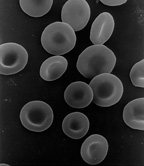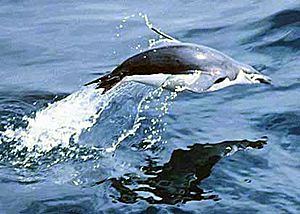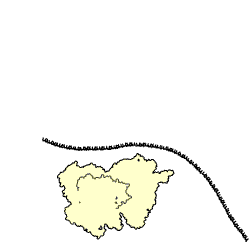Biomechanics facts for kids
Biomechanics is a cool field that studies how living things move and work, using the rules of mechanics. Think of it as looking at how your body, or even a tiny cell, acts like a machine. It's a part of biophysics, which mixes biology and physics.
In simple terms, biomechanics helps us understand the forces and movements inside our bodies and in nature. It's not just about movement; it also looks at things like chemistry, heat, and even electricity in living systems.
Contents
- What Does "Biomechanics" Mean?
- Different Kinds of Biomechanics
- How Fluids Move in Living Things (Biofluid Mechanics)
- How Things Rub and Wear in Living Systems (Biotribology)
- Comparing Movement in Different Animals (Comparative Biomechanics)
- Using Computers to Study Biomechanics (Computational Biomechanics)
- Studying Materials in Living Things (Continuum Biomechanics)
- How the Brain Controls Movement (Neuromechanics)
- How Plants Work Mechanically (Plant Biomechanics)
- The Science of Movement in Sports (Sports Biomechanics)
- How Blood Vessels Work (Vascular Biomechanics)
- The Mechanics of Immune Cells (Immunomechanics)
- Other Areas of Biomechanics
- A Look Back: The History of Biomechanics
- How Biomechanics Is Used
- See also
What Does "Biomechanics" Mean?
The word "biomechanics" came about in the late 1800s. It combines two old Ancient Greek words: bios, which means "life," and mēchanikē, which means "mechanics." So, biomechanics is literally the study of the mechanical rules that make living things move and hold their shape.
Different Kinds of Biomechanics
Biomechanics is a big field with many specialized areas. Here are some of them:
How Fluids Move in Living Things (Biofluid Mechanics)

This area studies how liquids and gases flow in or around living organisms. A common example is how blood flows through your body's cardiovascular system.
Imagine blood flowing through your veins and arteries. Sometimes, scientists can use complex math equations to describe this flow. When blood flows through very tiny vessels, like arterioles, individual red blood cells become important. They might even have to squeeze through in a single file! This changes how the blood interacts with the vessel walls.
Another example is how air moves in your lungs when you breathe. Scientists also study how insects breathe to get ideas for new tiny devices.
How Things Rub and Wear in Living Systems (Biotribology)
Biotribology looks at friction, wear, and lubrication in biological systems. This is super important for understanding how your joints, like your hips and knees, work.
When you move, the surfaces in your joints rub against each other. Biotribology studies how these surfaces interact, how they might wear down over time, and how the body's natural lubricants (like joint fluid) help them move smoothly. It also helps in designing artificial joints.
Comparing Movement in Different Animals (Comparative Biomechanics)

Comparative biomechanics applies the rules of mechanics to animals other than humans. This helps us learn more about how animals move, eat, and adapt to their environments.
Scientists study how animals run, jump, fly, or swim. Moving takes energy to fight against things like friction, air or water drag, and gravity. The most important factor changes depending on where the animal lives. For example, a fish needs to overcome water drag, while a bird needs to fight gravity to fly.
This field often helps us understand human movement better, and it also inspires engineers to create new designs based on nature (this is called biomimetics).
Using Computers to Study Biomechanics (Computational Biomechanics)
Computational biomechanics uses computer tools, like the Finite element method, to study how biological systems work. Scientists create computer models and simulations to predict how different parts of the body will react to forces or changes.
For example, computer models can help understand how plant cells grow or how bones respond to stress. In medicine, these computer models are very useful for planning surgeries or training doctors. They allow scientists to see what happens inside the body without needing to do experiments on living beings, which saves time and money.
Studying Materials in Living Things (Continuum Biomechanics)
This area looks at the mechanical properties of biological materials, like tissues and fluids. It helps us understand how these materials behave when they are stretched, squeezed, or twisted.
Living materials are often very complex and have a hierarchical structure. This means their strength and behavior depend on how they are built at many different levels, from tiny molecules all the way up to large organs.
Biological materials are often put into two groups:
- Hard tissues: Like bone, wood, or shells. These can often be studied using simpler rules of elasticity.
- Soft tissues: Like skin, tendons, muscles, and cartilage. These tissues can stretch and deform a lot, so studying them requires more advanced computer simulations.
Understanding these materials is important for developing realistic medical simulations and new treatments.
How the Brain Controls Movement (Neuromechanics)
Neuromechanics combines biomechanics with the study of the brain and nervous system. It helps us understand how your brain tells your muscles what to do to perform a movement.
Scientists use tools like motion capture (to record movement) and neural recordings (to see brain activity) to study how the brain and body work together during tasks like walking or reaching.
How Plants Work Mechanically (Plant Biomechanics)
This subfield applies biomechanical ideas to plants, their parts, and even their cells. It helps us understand how strong crops are against wind or how plants grow and develop. It also connects to mechanobiology, which studies how physical forces affect cells and tissues.
The Science of Movement in Sports (Sports Biomechanics)
In sports biomechanics, scientists use the rules of mechanics to understand how athletes move. This helps them improve performance and prevent injuries.
It looks at how muscles, joints, and bones work together during a sport. For example, it can analyze how a baseball player swings a bat or how a runner's legs move. Tools like strain gauges, digital filtering, and surface EMG (which measures muscle activity) are often used.
Understanding sports biomechanics can help athletes become better, recover from injuries, and avoid getting hurt in the first place.
How Blood Vessels Work (Vascular Biomechanics)
This area focuses on the mechanical behavior of blood vessels. Cardiovascular diseases are a major health concern worldwide. Your blood vessels are key for keeping blood flowing and exchanging important chemicals throughout your body.
Studying the mechanical properties of these complex tissues helps us understand heart and blood vessel diseases better. It also helps create more personalized treatments. Blood vessel walls are dynamic, meaning they are always changing based on their environment, like blood flow and chemical signals.
The Mechanics of Immune Cells (Immunomechanics)
Immunomechanics is a newer field that studies the physical properties of immune cells and how these properties affect their function. Scientists use special tools to measure forces on immune cells, often under normal body conditions.
They also look at how the mechanics of immune cells are connected to their metabolism (how they get energy) and how they signal to each other.
Other Areas of Biomechanics
Biomechanics is a very broad field and is used in many other areas, including:
- Animal locomotion and how animals walk or run.
- How the Cardiovascular system works.
- Designing things to fit the human body better (Ergonomy).
- Investigating injuries (Injury biomechanics).
- Designing Implant (medicine)s, Orthotics (supports), and Prosthesis (artificial limbs).
- Understanding how the muscles and bones work.
- Helping people recover from injuries (Rehabilitation).
- Studying how soft tissues move and deform (Soft body dynamics).
A Look Back: The History of Biomechanics
Ancient Times
The idea of biomechanics goes way back! Aristotle, a famous Greek thinker who lived around 300 BC, can be seen as one of the first biomechanics experts. He wrote a book called On the Movement of Animals, where he looked at animal bodies like machines. He also described how the ureter (a tube in your body) uses wave-like movements to carry urine.
Later, Galen (129-210 AD), a Roman physician, wrote a very important medical book called On the Function of the Parts. This book was the main medical guide for over 1,400 years!
The Renaissance
The next big steps in biomechanics happened during the Renaissance. In the 1490s, Leonardo da Vinci studied human anatomy and biomechanics. He understood how muscles create forces and how joints work. He even looked at how birds fly to try and figure out how humans could fly!
In 1543, a young scientist named Andreas Vesalius challenged Galen's old ideas with his own book, On the Structure of the Human Body. He corrected many mistakes that Galen had made.
Around the same time, Galileo Galilei, often called the "father of mechanics," made important biomechanical discoveries. He noticed that as animals get bigger, their bones need to get much thicker, not just longer, to support their weight. He also realized that bones are hollow to be strong but light. This was one of the first times someone thought about how nature "optimizes" its designs.
In the 17th century, Descartes suggested that all living things, including the human body (but not the soul), work like machines following mechanical laws. This idea really encouraged the study of biomechanics.
The Industrial Era
Giovanni Alfonso Borelli was a major biomechanics expert who followed Descartes' ideas. He studied how people walk, run, jump, how birds fly, and how fish swim, all using mechanical principles. He could even figure out the human center of gravity and how much air people breathe in and out. He showed that muscles have to produce much larger forces than the forces they are trying to overcome. Borelli's work is considered very important because he made so many new discoveries.
Later, in the 19th century, Étienne-Jules Marey used early cinematography (like making movies) to study how animals move. He was the first to connect the forces an animal puts on the ground with its movement. In Germany, scientists like Christian Wilhelm Braune used new engineering ideas to study human walking.
Around the same time, engineers like Karl Culmann and anatomists like Hermann von Meyer compared the stress patterns in a human thigh bone (femur) to those in a crane. This led to Julius Wolff proposing Wolff's law, which says that bones change and adapt based on the stresses put on them.
Today, biomechanics is a huge and growing field with many institutions and labs around the world. The American Society of Biomechanics was created in 1977, showing how much the field has grown.
How Biomechanics Is Used
Biomechanics is used in many different ways, from understanding tiny cells to the movement of whole animals and the properties of bones.
Here are some examples:
- Studying the forces on your limbs when you move.
- Understanding how birds and insects fly (aerodynamics).
- Analyzing how fish swim (hydrodynamics).
- Learning about how all living things move, from single cells to large animals.
With a better understanding of how living tissues behave, scientists can improve tissue engineering (creating new tissues) and develop better treatments for many diseases, including cancer.
Biomechanics also helps us study the human muscles and bones. Researchers use special platforms to measure the forces your feet put on the ground and infrared cameras to track your body's movements in 3D. They also use electromyography to see how your muscles activate in response to forces.
In the medical industry, biomechanics is used to design artificial joints for hips and knees, dental parts, and other medical devices. Biotribology is a key part of this, as it helps improve the design of materials used in these implants to make them last longer and work better.
Biomechanics is also closely linked to engineering. It often uses traditional engineering sciences, like continuum mechanics and structural analysis, to study biological systems. Because biological systems are often more complex than human-made machines, scientists often use computer models and simulations, along with experiments, to understand them better.
See also
- Biomechatronics
- Biomedical engineering
- Cardiovascular System Dynamics Society
- Evolutionary physiology
- Forensic biomechanics
- International Society of Biomechanics
- List of biofluid mechanics research groups
- OpenSim (simulation toolkit)
- Physical oncology


